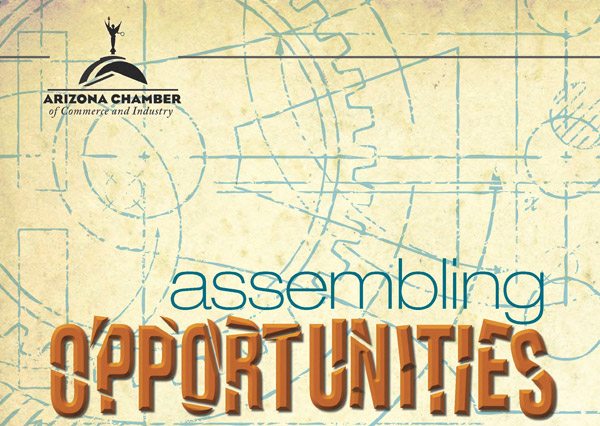Gov. Jan Brewer has done a lot to make Arizona more competitive for manufacturing, economic development leaders say.
“The repeal of the energy sales tax on gas and electricity is very big for us,” says Mark Dobbins, co-chairman of the Arizona Manufacturing Partnership at the Arizona Chamber of Commerce and Industry. “We have a business friendly reputation and this change makes a big difference in our attractiveness to manufacturing.”
But there is one piece of the puzzle that still creates concern.
“Businesses wanting to relocate to Arizona are impressed with the business-friendly climate in the state,” Dobbins continues. “The question I hear most is, ‘Will I find an educated and experienced workforce for my business?’”
Concerns over education bring the Partnership and other economic development advocates around to the next focus — a quality, educated workforce to serve Arizona’s growing job demand. The conversation started with business, the community colleges, state universities and schools during the depths of the recession.
“The tax cut makes a major difference for a corporation,” says Barry Broome, CEO of the Greater Phoenix Economic Council. “Tesla, if it locates here, saves $30 million to $40 million a year with that bill in place.”
Broome considers SB1413 the most important bill for business in the current session. “The (manufacturers electricity sales tax) exemption brings us in line with most of the rest of the country; only 15 states had such a tax. For big power users, this is a make-or-break proposition. High technology companies spend more on power than payroll.”
“Continuous innovation is what keeps Arizona competitive in manufacturing,” says Sandra Watson, CEO of the Arizona Commerce Authority. “We believe that the future is in research and development and Arizona has one of the most competitive R&D tax credits in the country.”
The ACA manages that tax credit and it’s not handed out lightly or just for large manufacturers. The state has seen much of its manufacturing employment growth, now six percent of the workforce, from the smaller businesses. The ACA makes the credit available to any sized qualifying firm.
The state’s manufacturing history is sometimes lost in the ads for golf courses and new subdivisions. “We have a history of solid manufacturing in the state that goes back 50 or 60 years,” recounts Steve Macias, president and CEO of Pivot Manufacturing, Arizona Commerce Authority board member, and chairman of the Arizona Manufacturers Council, which falls under the umbrella of the Arizona Chamber of Commerce and Industry. “This gives us a solid workforce with experience, ability and productivity that is a plus for any manufacturer wanting to relocate or expand.
In addition to the cut on the utility sales tax, SB1484 was another breakthrough for manufacturers. The bill created energy tax credits that can be claimed by manufacturers generating renewable energy to power Arizona operations.
Dobbins says that Arizona has all the right assets in place for manufacturing today, but can’t rest on what we have now for the future. “We need to invest more to build our assets up,” he says. “We need a lot of work to build our competitive logistics infrastructure.”
He lists logistics where the state needs to invest more money and projects. “We’re in great shape when it comes to passenger traffic with Sky Harbor and (Phoenix-Mesa) Gateway airports. We need to do more for air freight.”
Dobbins believes Arizona’s manufacturing future is in building our exports with Canada, Mexico and South America. He’s not alone in that view. State Transportation Board Member Joseph La Rue emphasizes the same position. “Interstate 11 makes this market a crossroads. Right now, we’re just connected to the east and west.”
The state is taking effective action, says Macias. “With the change in (sales tax on energy) and (research and development) tax credit, we’re a state that is very appealing to a capital intensive business. Arizona is moving in the right direction.”
Arizona’s manufacturing opportunities are spread across the state. Most people think of Phoenix, Tucson and Yuma as the places where the businesses cluster, but small manufacturers are seeing emerging markets in Flagstaff, Prescott and Kingman, according to Dobbins.
With the tax credits and incentives offered through the ACA and some local governments, Macias says a small manufacturer can take advantage of an underemployed workforce in a rural area. Arizona provides significant tax credits and incentives for businesses to train and develop their employees. These come through ACA and the Department of Economic Security Workforce Arizona programs.
“We’ve always had aerospace, defense and semiconductors as our base,” says Broome. “We’re starting to build manufacturing industry clusters in high technology glass. GT Advanced Technology in Mesa and Rioglass Solar Steel in Surprise are a start. Once businesses start to cluster, more become interested because it means there’s a growing, skilled workforce.”
“We need to do more to build our workforce,” says Dobbins. “Arizona has consistently underfunded education and we’re paying that cost now. Common Core standards will give us a business-accepted measure of how our workforce stacks up. We don’t just mean in college education, but also in the important areas of technical education.”
“Common Core (education standards) are driven by business so that there is a national standard of comparison,” says Macias. “We’ve been working on the need for a trained and educated workforce so that we don’t slip into a deep recession in the future. We were too dependent on construction.”
Arizona needs to get the word out, experts say.
“When people come in to Sky Harbor, they’re overwhelmed with ads for golf, resorts and housing,” muses Macias. “That’s why they’re here in the winter. We need to overwhelm them with a message of what we do in Arizona. We do a lot, and we do it very well.




